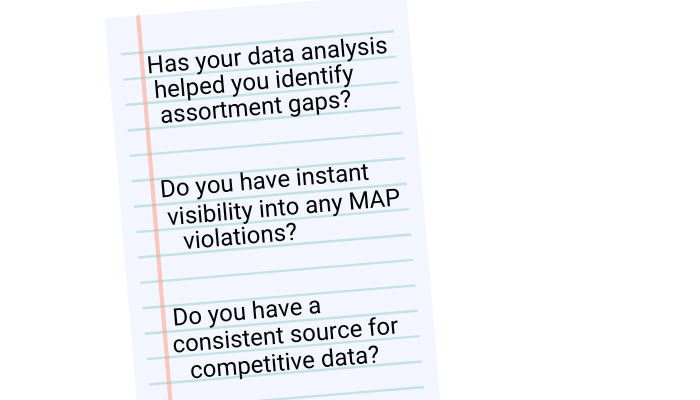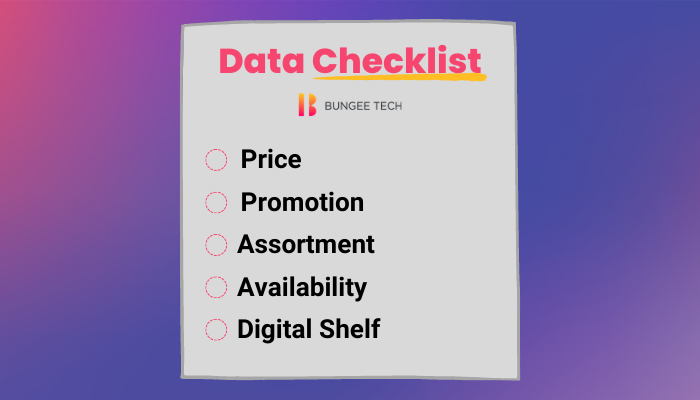Data Checklist: The Data Retailers and Brands Need to Succeed
What You’ll Learn:



Hosted by Rajat Nigam, CEO and Founder, Bungee Tech
Watch the session now
Retail and CPG Success Metrics
What are your key success metrics? This answer changes depending on the year… on consumer demands… even on the location.
Before we consider businesses success metrics, let’s think about what drives the consumer.
On their buying journey, consumers think of success in terms of value, convenience, quality, experience (both on digital and physical channels), and operations.
Let’s break these down.
» Value. This one seems intuitive. Offer competitive prices. Provide worthy products with the right price-pack architecture. Create an experience consumers appreciate.
» Experience. Consumer behavior is demand is blending convenience and experience across digital and physical boundaries. Consumers want an easier way to shop online. Convenience options like curb side pickup ties together the digital and physical world to create a new omnichannel experience. It is not a surprise that the digital share of grocery sales more than doubled during the pandemic from 5% to 10%. That’s here to stay.
Operations. This consumer preference driver really focuses on product availability and consistency (in pricing, promotions, assortment).
Now, let’s create a formula for those consumer preferences and input your measures of success.
Back to business success metrics. They include customer satisfaction, foot traffic, and digital traffic. Retailers might focus on average transaction value. CPGs might look closely at marketing spend.
In my experience, brand and retail businesses both talk about success in terms of:
Increasing conversions. In today’s competitive marketplace you want to win the moment of purchase – every time.
Reducing out of stocks. This goal took on a new life during the pandemic and is still something retailers and brands keep a close eye on.
Inventory turnover. A high inventory rate suggests better performance and reduced inventory write-offs. While a lower inventory turnover might signal some inefficiencies.
Profitability. The profit margin is a key indicator of your business’s health.
To achieve success and account for consumer preference drivers – you need quality competitive data to make smart decisions. That data has to show you the whole picture.
So let me ask you a couple of questions…
For retailers – Can you price your assortment competitively across all channels & competition? Do your product matches keep pace with competitor catalog changes for hundreds of retailers? Is your data and existing analytics helping you identify and close profitable assortment gaps?
For brands – Do you have visibility into MAP violations in an omnichannel world across hundreds of retail destinations, across channels and across locations? Are you familiar with your out-of-stock trends? Can you benchmark pricing?

+ Do you really know who your competition is?
+ How do you determine product assortment and/or pricing to maximize sales?
+ Do you have a consistent source for competitive data?
If you’re shaking your head “yes” … you’re in a great position. It seems like you have reliable data.
If you’re thinking “no” or maybe you’re unsure… you’re in the right place… There’s a strong chance your business needs to consider a more modern approach to digital data and intelligence.
Data Checklist
You should confidently answer those questions with price, promotion, digital shelf, availability, and assortment data. These data areas are critical to a brand & retailers’ success.
Think about it like this…
Today’s shoppers are diverse. They want to try new products, explore new shopping destinations, and buy from new channels. They have information at their fingertips and an infinite choice on the digital shelf.
The holy grail for brands and retailers is meeting this shopper where they are in their buying journey and winning the moment of purchase. That can only happen when retailers and brands deliver on those consumer preferences like price-value, the right assortments, and a great omnichannel shopping experience.
If you’re manually gathering data today, it might be inaccurate.
If you rely on in-store audits, that data is probably delayed.
If you don’t trust your current process, you could be leaving money on the table.
We solve for those common challenges of inaccuracy, infrequency, and unreliability.
First, what is competitive intelligence? Competitive intelligence refers to the ability to gather, analyze, and use information collected on competitors, catalogs, and product attributes as an advantage. Competitive intelligence helps businesses like yours understand their marketplace and the opportunities and/or challenges it presents. Consumer goods manufacturers & retail businesses analyze the information to create effective and efficient business practices.
After years of working with premier retailers and manufacturers, we’ve seen smart data strategies and we’re here to share that with you.

Price Monitoring
Let’s talk about price monitoring. Whether you follow hi-lo pricing or EDLP or dynamic pricing throughout the day, price is a critical business element – you need to enhance your strategy, increase market share, and recognize trends.
A couple things:
1… Inflation. It affects business, and it impacts consumers. Shoppers (at least for now) are willing to trade down on quality if the price is right.
2… 88% of shoppers compare prices while shopping online. Again, signaling that price is a top priority for shoppers.
These facts tell me:
If you position yourself to be the price leader… you’ll increase loyalty and conversions.
And being the leader does not always mean that you drop prices or adopt the image of a discount destination. You can increases the prices when needed looking at the market opportunities. The goal should be providing a price-value perception for your targeted customer segment that promotes and drives a purchase decision. Customers want value for money whether they are buying a everyday utility or a luxury product and nothing speaks louder to them than the price-value.
On the CPG side, its important to protect your brand and proactively monitor for MAP and UPP compliance across the market and at a zip code level. You also want to look at competitor price-pack architectures across channels to discover pricing opportunities.
Promotional Comparisons
Good promotions are designed to drive a systemic, long term behavioral change along with the more immediate increase in sales during the promotion and halo effect after that.
Your goal as a business in response to competitor promotions is to intercept the shoppers journey with a winning price-value offer to continue retaining your loyal customers. Monitoring promotional data unlocks insights into competitors’ discounting strategies. identify promotional opportunities for yourself.
Competency of your promotion monitoring strategy is directly related to:
👉 Consistently and accurately capturing the details of the promotion and inventory positions.
👉 Second, just like prices, translate a promotional offer to relevant price pack architectures across channels is extremely important. For example, accurately assessing the dollar discount associated with a competitor BXGY promotion and translating it to a possible price change for the same products you may be carrying with a different pack size.
👉Third, ability to monitor the impact of the promotion on the relevant categories during the promotional period. For example, its imperative to monitor data points like growth in reviews and ratings and shifts in search rankings and positions for the category and sales uplift are imperative for deciding your counter offense.
👉Finally, monitoring promotions across channels and zip codes throughout the country is a decisive differentiator in your ability to respond to competition.
Assortment Gap Management
When it comes to assortment, you’re making decisions that drive traffic, conversion, and cash flow.
Offering products that customers love make you the go to shopping destination or the go to brand that fuels customer loyalty.
As a retail business you want to ensure thoughtful and profitable selection growth understanding the physical limitations and realities of fulfillment center you operate and in store shelf space available. It’s imperative that you look at assortment gap data that gives you a comprehensive of view of your competitors selection at an item level with all variations of size, color, price-pack architectures, across the market and where applicable at a zip code level to make the right expansion choices for your customers and your business.
As a brand, you want to monitor your assortment distribution across markets and identify expansion opportunities, find price-pack re-architecture opportunities across channels and discover and monitor new product as they launch and rise in the market.
A competent assortment gap management program should:
👉 Identify item and brand gaps from all your competitors against your product catalog and that should be an ongoing process.
👉 It’s imperative that any gaps should be grouped accurately into product and brand clusters across all your competitors to provide an accurate assessment of the opportunity. For example, you may want to onboard a 5 star great selling product that 30 different retailers carry versus another product with lesser adoption.
👉 Finally, you want trusted prioritization based on parameters like customer feedback, reviews, ratings, revenue impact and economic scoring of a selection gap opportunity and compare it against others.
Availability & Out of Stock
Accurately managing availability data can be the difference between winning or losing that moment of purchase.
Availability data is a gold mine which can be used to drive a number of strategic inputs to efficiently operate business everyday.
For example, as a retailer you may use availability information of the competitor’s catalog to adjust pricing for overlapping selection, or provide compelling offers for comparative national brand or even private label products.
As a brand you want to track availability data for your own products to identify and address supply chain issues OR identify promotions where you are losing money. And you want to track your competitor’s availability to find the right advertising opportunities or sponsoring EDLP offers to drive a shift in consumer behavior.
We believe that a competent program tracking availability data:
👉 First, consistently and accurately capture availability across channels, when needed at a zip code level, everyday and intraday with real time notifications and action driving recommendations.
👉 Accurately match products across catalogs to authoritatively paint a picture of availability across the country factoring in all product variations and price pack architectures available in the market.
👉 Look at historical trends for future planning and have predictive analytics to identify possible future OOS events with proactive notifications.

Digital Shelf Analytics
Success might mean first-page visibility. Using digital shelf analytics will help brands understand the consumer buying experience and focus on discovery and availability of their items against competitors operating in their category. As a retailer you want to discover and compare the digital shelf experience you offer against competitors to identify improvement opportunities in terms of selection, pricing, availability and content.
Your Secret Weapon
- Attain uninterrupted data from hard-to-access sites and hard-to-match categories
- Reconcile product info across sources to stitch together a real-time picture of the marketplace
- Generate differentiated price, promotion, assortment, and availability analytics on top of it






